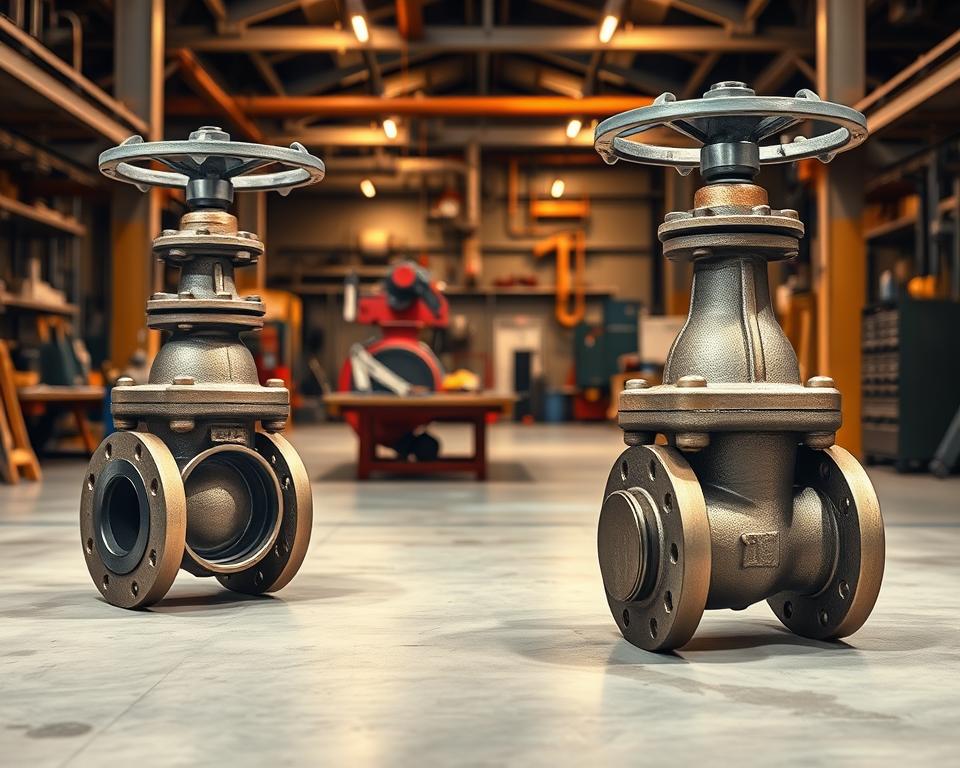Cast-Iron Gate Valves: Long-Lasting Utility Flow Control
Quick stat: Over sixty percent of city water mains continue to use traditional shutoff hardware for dependable isolation during emergencies.
Explore our workhorse line of Cast Iron Gate Valve Manufacturer built for long life in plant, building, and municipal use nationwide. Each unit pairs a sturdy body-and-bonnet assembly with a proven gate design to withstand wear and cut corrosion under fluctuating pressure/temperature cycles.
The full-bore gate minimizes flow restriction when open, supporting transfer of water and suitable media with less pressure loss. Designers and maintenance teams value the simple serviceability, common connection options, and easy-to-source parts that streamline selection and repairs.
This portfolio covers a variety of series and ratings to match common duty ranges, end connections, and operator preferences. Expect consistent sealing, uniform operating torque, and economical ownership centered on uptime and low life-cycle cost.
Why It Matters
- Built for durable shutoff and dependable flow control in demanding environments.
- Rugged construction helps resist wear, corrosion, and mechanical stress.
- Gate design offers minimal resistance and reduced pressure loss.
- Available in a range of series and class ratings to meet typical requirements.
- Service-friendly design, common parts, and predictable sealing improve uptime.
Cast Iron Gate Valves for Reliable, Precise Flow Control
Purpose-built shutoff valves with precision wedges and machined seats provide steady performance across commissioning, operation, and shutdown cycles. Rigid iron bodies and close-tolerance seating produce repeatable sealing. That consistency supports safe isolation and minimizes unplanned downtime.
Smooth-operating characteristics cut handwheel effort and let technicians position the wedge with confidence. Straightforward stems and common accessories simplify adapting a valve to manual handles or actuators. Reduced effort streamlines routine checks and repairs.

Stem Options and Performance
| Attribute | Rising-Stem | Compact NRS |
|---|---|---|
| Position visibility | High — visual indicator | Low — compact design |
| Space requirement | Requires vertical space | Better for tight or buried service |
| Inspection | Accessible for checks | Low profile with similar longevity |
When fully opened, the unobstructed passage provides low pressure drop and high efficiency flow. Leak-tight closure limits leakage risk and maintains target pressure for downstream equipment. Together, these qualities trim ownership cost and enhance system uptime across common commercial and light industrial applications.
Design Choices and Options: Cast Iron Gate Valves
Detailed design choices—body material, stem style, and flange pattern—determine fit and performance as well as serviceability.
Body & Bonnet Construction
The body and bonnet are cast iron for strength and vibration resistance. Precision-machined guides maintain gate alignment for consistent sealing.
Rising Stem vs Non-Rising Stem
A rising stem offers a clear visual position indicator and is simple to inspect but requires overhead space. A non-rising stem saves overhead space and protects threads within the bonnet.
Both stem designs pair with standard handwheels and can be prepared for actuators or external position indicator accessories when automation is required.
Class 125 performance guidance
Class 125 rating is common for water and general service within moderate temps. Check published pressure-temperature limits to verify suitability for the intended operating envelope.
Connections and Face-to-Face Dimensions
| Parameter | Spec | Details |
|---|---|---|
| Flange drill pattern | ASME bolt pattern | Compatible with typical piping |
| End-to-end | Per industry series | See datasheet for dimensions |
| Bolting | Specified grade/torque | Gasket choice influences seal |
- Sizes and series: from small diameters up to large mains with multiple series and trim options for long life and easy service.
- Internal trim: seat/wedge materials optimize tight shutoff and longevity; enhanced packing and bonnet gaskets bolster stem sealing.
- Integration tips: double-check dimensions, bolting, and torque prior to install.
Applications, Codes, and Integration
Applications for these Resilient Seated Gate Valve span municipal water mains, building risers, and pump-room isolation points where dependable shutoff is critical.
Water distribution and fire systems routinely deploy these as sectional and control valves. They provide readable position and robust shutoff for life-safety and utility networks.
Flow, shutoff, and bi-directional service
The gate design supports shutoff in either flow direction when installed to manufacturer instructions. This adaptability simplifies piping layouts and works with redundant runs.
Serviceability and Bonnet Integrity
Accessible bonnet bolts, guided gates, and serviceable packing streamline inspection/repacking. Correct packing compression keeps stem sealing under frequent operation.
OS&Y Indicators and Best Practices
Outside indicators and OS&Y styles provide visible open/closed status for inspections. Even with two-way capability, adhere to the recommended orientation and clearance guidance to ensure safe operation.
| Application | Key Benefit | What to Verify |
|---|---|---|
| Municipal mains | Secure isolation | Verify Class 125 limits |
| Fire protection | Inspector-friendly indication | Use indicator or OS&Y option |
| Pump stations | Maintenance friendly | Match flange and face-to-face dimensions |
Final Thoughts
Opt for proven shutoff equipment with robust construction and predictable flow control.
You get durable isolation and consistent control for water and utility applications. Count on straightforward installation and easy maintenance for lasting reliability.
Key specs include class 125 rating, a robust body and bonnet, and designed stem sealing to maintain performance across building and plant environments.
Multiple series and common sizes, plus handwheel or actuator-ready configurations, simplify system matching. Visible position indication and smooth stem travel enhance daily operation and response under variable conditions.
The wedge-and-seat design supports leak-tight closure and low pressure drop. Confirm sizes, end connections, and accessories at specification time to accelerate purchasing and commissioning.
Choose valves manufactured to stringent standards. We can review class, sizes, and series to align selections with your operating and maintenance goals.
